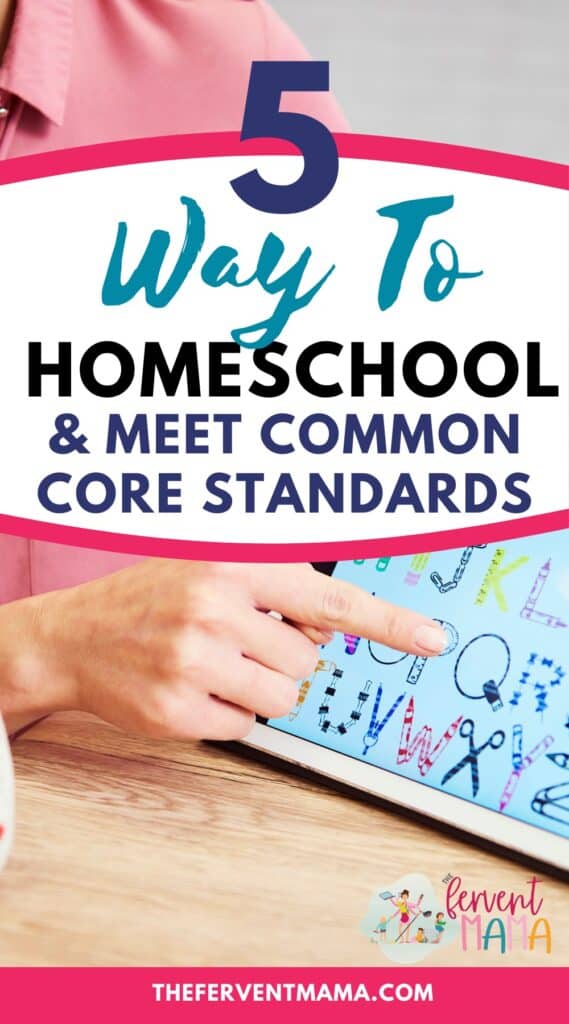5 Ways to Have a Relaxed Homeschool and Still Meet Common Core Standards
The Fervent Mama uses Affiliate Links. See our disclosure policy here.
Homeschooling requirements vary from state to state, and here in California, we can homeschool through a charter school.
There are many benefits to homeschooling with a charter school, like funds to purchase curriculum and school supplies, but the one downfall that most relaxed homeschoolers balk at is the need to meet Common Core Standards.
However you may feel about the standards, there are ways to ensure that your homeschool can still be a relaxing, stress-free learning environment while still meeting the requirements.
5 Ways to Have a Relaxed Homeschool and Still Meet Common Core Standards
In this post, I’ll go into detail about the relaxed homeschool approach, charter schools in California, Common Core Standards, and the five simple ways we meet those standards without sacrificing our relaxed vibe.

What Is Relaxed Homeschooling?
Relaxed homeschooling is a mindset, and the definition is very subjective as each family that embraces the lifestyle applies it differently.
For our family, a relaxed homeschool has a natural daily rhythm in place of a strict schedule, it is child-led with many fun, hands-on activities, we allow for flexibility, spontaneity, and creativity, and we ensure that our home environment is a safe, positive, and comfy place to learn.
The process for us to get to this relaxed state of mind included years of deschooling on my part and lots of trial and error regarding curriculum choices and homeschooling philosophies.
How Does Homeschooling through a Charter School Work?
There are several ways to legally homeschool in California to meet the mandatory school attendance laws. The most popular way in recent years is to homeschool through a public charter school.
There are various homeschool charter schools in California. Each has different offerings, but they all have a stipend for each child enrolled to purchase approved curriculum, enrichment activities, and school supplies.
The amount of money each child receives for their education varies from charter school to charter school and the grade level of the student. For example, high school students would receive more funding to cover classes and textbooks than a kindergartener.

In exchange for this stipend, children are required to meet with their assigned homeschool teacher every 20 days (parents are considered co-teachers), submit schoolwork each learning period that aligns with the Common Core Standards, and participate in state testing.
What Exactly Are Common Core Standards?
Education standards have been around for years and are learning goals created by each state for their students. These standards vary from state to state, and in 2009 government and educational leaders from 48 states got
together to develop a set of common learning goals for language arts and mathematics. Leaders termed these goals Common Core State Standards.
The final version of the Common Core State Standards was published in 2010 for states to review and consider adopting. Forty-one of the 50 states opted to replace their ELA and Math standards with Common Core in the hopes of making educational outcomes consistent around the country.
Important to note: States voluntarily adopt the Common Core State Standards for ELA and Math, but they still use their own state standards for Science, History, and Physical Education.
Also, curricula based on those standards are chosen at the district level, so what a student learns and how a teacher presents the information can still vary greatly.
How Do You Maintain a Relaxed Homeschool While Still Meeting the Common Core Standards?
Easy, by not stressing about it!

Public school educators know that there is no way to cover all of the standards in a given year.
Have any of you ever finished a curriculum or textbook from cover to cover? I know I never have as a student, a middle school history teacher, or a homeschool parent.
Instead, the standards are seen as a framework or guide to help teachers plan as a team for their school year.
5 Tips to Help YOU Not Stress About the Standards
– Print them out!
Search for your state’s standards or if you’re in California, ask if your charter school has an “I Can Statement,” a simplified version of the criteria, for each subject and appropriate grade level.
Print them out and make yourself familiar with your state’s standards.

So you’re thinking about homeschooling in Louisiana?
103 shares Share102 Tweet Pin1 NOTE: I am not a lawyer and this is not legal advice. Please read and/or refer to the Louisiana State Laws for Homeschooling information and websites that are referenced in this article. Homeschooling seems to be more and more popular these days, and I really don’t blame people for making…
– What is the big picture?
If you look carefully, you’ll notice that those standards are broken down into smaller and even smaller chunks that can seem overwhelming if you’re not familiar with them.
I’ve always felt that the creators of the standards did this more for the curriculum developers than for the teachers.
I recommend not worrying about the details, as they’ll fall naturally into place when you’re studying the topic. Instead, look at the big picture and make a simple backward plan of your school year so you can have a general idea of the units your kids will study.
– Loosely Plan Your Units
I like to plan out our year six weeks at a time based on our household’s season and emotional climate. I don’t go into details but instead find curriculum and resources to use, gather our notebooks and needed supplies, search for interesting videos to watch and activities to participate in, and find fun field trips to go on.
And then we may do just half of what I gathered.
I’ve learned from experience that planning out the whole year in detail never quite works out for our home. We need A LOT of flexibility and time for field trips and other spontaneous activities. Plus, the fewer things on our to-do list, the more stress-free our homeschool is.
– Check them off!
Every month, our charter school teacher and I go over these standards for each child, and she marks the ones we covered.
Once your child has mastered the standard, there’s no need to go back and do it again. Notate and move on.
You can also do this on your own every few weeks, or at the end of a unit with the list of standards you printed out.
Don’t forget to save any work that specifically correlates with a standard in case you need to submit it to your charter school or need a portfolio as part of your state requirement.
– Keep to YOUR Family’s Homeschool Mission & Vision
It’s easy to get overwhelmed or in a frenzy (depending on your personality type) when it comes to completing goals and checklists. Remember that the standards are not an end-all; instead, they are merely a framework for you to work within.
If you find yourself starting to worry about the standards, it may be time to take a step back to review your homeschool mission and vision.
Regularly reassessing and realigning your homeschool is essential since it’s so easy to get off track.
I try to do this at the end of each 6-week session. We usually take 1-2 weeks off between each unity study, and I use this time to reflect on our homeschool and plan out the next 4-6 weeks, making any necessary readjustments.
Of course, there are many other ways to make a relaxed homeschool work with Common Core State Standards, but these five tips should give you some good ideas on how to loosen up and enjoy a stress-free homeschool while staying in compliance with state requirements.
Not only will you keep your sanity, but you can do it without giving up too much ground when it comes to home education.
How do you manage to have a relaxed homeschool while still meeting Common Core Standards? What tips can you share with us?

This is a contributed post for the 2021 How We Homeschool Series.
Learn more about the How We Homeschool Series, contributors, sponsors, and giveaways by heading here.























